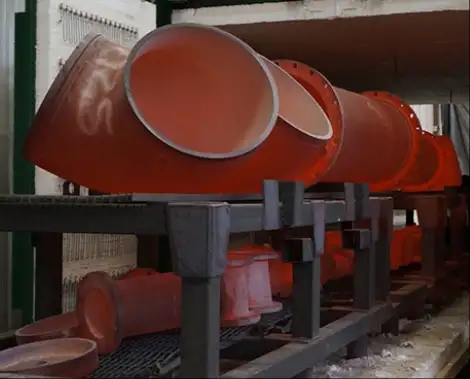في حين أن كلاً من الأكسدة والصدأ تؤثر على حديد الدكتايل، فهي تمثل عمليات تآكل مختلفة مع استراتيجيات وقاية مختلفة. الأكسدة طبقة زنجار واقية (طبقة أكسيد الحديد) التي تبطئ من المزيد من التحلل، في حين أن الصدأ (هيدروكسيد أكسيد الحديد) هو منتج تآكل قشاري مدمر ناتج عن الرطوبة والإلكتروليتات. وبالنسبة لأنابيب حديد الدكتايل تشمل الحماية الفعالة ما يلي:
-
غلاف من البولي إيثيلين (AWWA C105) للأنابيب المدفونة
-
طلاءات الإيبوكسي/البولي يوريثان للأسطح المكشوفة
-
الحماية الكاثودية في البيئات عالية الخطورة
تعرّف على كيفية تحديد تركيبة المواد والعوامل البيئية لمعدلات التآكل، ولماذا تُعد الطلاءات المناسبة ضرورية لطول عمر البنية التحتية.

🔬 الأكسدة مقابل الصدأ: تعريف المصطلحات
الأكسدة
الأكسدة عبارة عن تفاعل كيميائي يتفاعل فيه المعدن مع الأكسجين، مكونًا طبقة أكسيد على سطحه. في حديد الدكتايل تؤدي هذه العملية في حديد الدكتايل إلى تكوين طبقة أكسيد واقية يمكنها حماية المعدن الأساسي من المزيد من التآكل. عادةً ما تكون طبقة الأكسيد هذه مستقرة وتلتصق جيدًا بالسطح المعدني، مما يوفر درجة من الحماية.
الصدأ
الصدأ هو نوع محدد من التآكل الذي يحدث عندما يتفاعل الحديد مع الماء والأكسجين، مكونًا أكسيد الحديد (Fe₂O₃₃-nH₂O). على عكس طبقة الأكسيد الواقية التي تتشكل أثناء الأكسدة، فإن الصدأ متقشر ومسامي ولا يلتصق جيدًا بسطح المعدن. وتسمح هذه الخاصية للرطوبة والأكسجين بالتغلغل بشكل أعمق في المعدن، مما يسرّع من عملية التآكل.
🧪 آليات التآكل في حديد الدكتايل
على الرغم من أن حديد الدكتايل أكثر مقاومة للتآكل من الحديد الزهر التقليدي، إلا أنه ليس محصنًا ضد التآكل. تشمل آليات التآكل في حديد الدكتايل ما يلي:
-
الرسم البياني: ترشيح الحديد من البنية المجهرية، تاركًا وراءه رقائق الجرافيت التي يمكن أن تضعف المادة.
-
التآكل الناجم عن التأليب: تآكل موضعي يؤدي إلى تكوين حفر على سطح المعدن.
-
التآكل المنتظم: حتى التآكل عبر السطح، وغالبًا ما يرجع ذلك إلى عوامل بيئية مثل تركيبة التربة أو كيمياء المياه.
إن فهم هذه الآليات ضروري لتنفيذ استراتيجيات فعالة للتحكم في التآكل.
🛡️ تدابير الحماية من التآكل 🛡️ تدابير الحماية من التآكل
1. الطلاءات والبطانات
تطبيق الطلاءات أو البطانات الواقية يمكن أن يعزز بشكل كبير من مقاومة حديد الدكتايل للتآكل. تشمل الخيارات الشائعة ما يلي:
-
طلاءات الإيبوكسي: توفير حاجز ضد الرطوبة والمواد الكيميائية.
-
تكميم البولي إيثيلين: يوفر الحماية في ظروف التربة القاسية.
-
بطانات الملاط الأسمنتية: تُستخدم في أنابيب المياه لمنع التآكل الداخلي.
2. الحماية الكاثودية
تتضمن هذه التقنية تطبيق شحنة كهربائية صغيرة ومستمرة على المعدن لمواجهة التفاعلات الكهروكيميائية التي تسبب التآكل. وهو فعال بشكل خاص في خطوط الأنابيب المدفونة.
3. الصيانة والفحص الدوري
يمكن أن تساعد عمليات الفحص الروتينية في الكشف عن علامات التآكل المبكرة، مما يسمح بالتدخلات في الوقت المناسب. تشمل ممارسات الصيانة التنظيف ومراقبة الظروف البيئية وإصلاح أي تلف في الطلاءات الواقية.
📊 نظرة عامة مقارنة: الأكسدة مقابل الصدأ
| الميزة | الأكسدة (وقائي) | الصدأ (مدمر) |
|---|---|---|
| شروط التكوين | التعرض للأكسجين | الماء + الأكسجين |
| المظهر | طبقة أكسيد مستقرة | متقشر، بني مائل للحمرة |
| الالتصاق بالمعدن | قوي | ضعيف |
| الصفات الوقائية | نعم | لا يوجد |
| تسريع التآكل | لا يوجد | نعم |
🧭 أفضل الممارسات لصيانة حديد الدكتايل
لتعظيم العمر الافتراضي لمكونات حديد الدكتايل:
-
اختر المواد المناسبة: اختر السبائك أو الطلاءات المقاومة للتآكل بناءً على الظروف البيئية.
-
تنفيذ التدابير الوقائية: استخدم الطلاءات والبطانات والحماية الكاثودية حسب الحاجة.
-
إجراء عمليات تفتيش منتظمة: مراقبة علامات التآكل ومعالجة المشكلات على الفور.
-
الحفاظ على التحكم البيئي: إدارة عوامل مثل الرطوبة والتعرض للمواد الكيميائية التي يمكن أن تسرّع من التآكل.
❓ الأسئلة المتداولة (FAQs)
1. ما الفرق بين الأكسدة والصدأ في حديد الدكتايل؟
تشير الأكسدة إلى تكوين طبقة أكسيد مستقرة على سطح حديد الدكتايل عند تعرضه للأكسجين. يمكن لهذه الطبقة حماية المعدن الأساسي من المزيد من التآكل. أما الصدأ، من ناحية أخرى، فهو شكل من أشكال التآكل الذي يحدث عندما يتفاعل الحديد مع الماء والأكسجين، مما يؤدي إلى تكوين أكسيد الحديد المتقشر الذي لا يلتصق جيدًا بسطح المعدن، مما يسمح بحدوث المزيد من التآكل.
2. كيف يمكنني منع التآكل في أنابيب حديد الدكتايل؟
تشمل التدابير الوقائية تطبيق الطلاءات الواقية مثل بطانات الإيبوكسي أو الملاط الأسمنتي، واستخدام تكميم البولي إيثيلين في ظروف التربة العدوانية، وتنفيذ أنظمة الحماية الكاثودية. كما أن الصيانة والفحوصات الدورية ضرورية أيضاً لاكتشاف علامات التآكل المبكرة ومعالجتها.
3. هل حديد الدكتايل أكثر مقاومة للتآكل من الحديد الزهر؟
نعم، يتميز حديد الدكتايل بمقاومة فائقة للتآكل مقارنةً بحديد الزهر. ويرجع ذلك إلى بنيته المجهرية التي توفر قوة وصلابة أفضل، مما يقلل من احتمالية حدوث أعطال مرتبطة بالتآكل.
4. هل يمكن إزالة الصدأ من حديد الدكتايل؟
نعم، يمكن إزالة الصدأ باستخدام طرق ميكانيكية مثل التنظيف بالفرشاة السلكية أو السفع الكاشط، يليها وضع طلاءات واقية لمنع المزيد من التآكل.
5. ما هي علامات التآكل في مكونات حديد الدكتايل؟
تشمل العلامات تغير اللون، والتنقر، والتقشر السطحي، وفي الحالات الشديدة، ضعف الهيكل أو انثقاب المعدن. يمكن أن تساعد عمليات الفحص المنتظمة في تحديد هذه العلامات مبكراً.
🧾 الخاتمة
إن فهم الاختلافات بين الأكسدة والصدأ أمر ضروري للحفاظ على سلامة مكونات حديد الدكتايل. في حين أن الأكسدة يمكن أن توفر طبقة واقية، إلا أن الصدأ يشير إلى التآكل المستمر الذي يمكن أن يضر بقوة المادة. إن تنفيذ التدابير الوقائية المناسبة والصيانة الدورية يمكن أن يعزز بشكل كبير من عمر منتجات حديد الدكتايل وأدائها.
